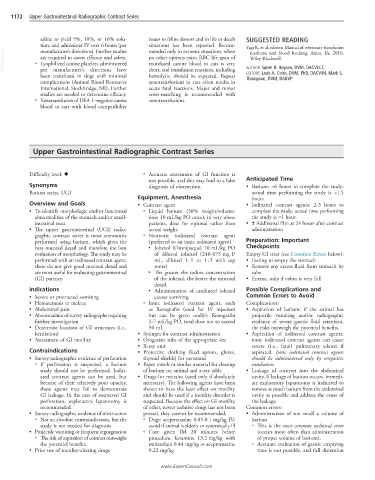Page 2368 - Cote clinical veterinary advisor dogs and cats 4th
P. 2368
1172 Upper Gastrointestinal Radiographic Contrast Series
saline to yield 5%, 10%, or 16% solu- issues to feline donors and in life or death SUGGESTED READING
tion, and administer IV over 6 hours (per situations has been reported. Recom- Yagi K, et al, editors: Manual of veterinary transfusion
manufacturer’s directions). Further studies
mended only in extreme situations, when
VetBooks.ir ○ Lyophilized canine platelets administered no other options exist; RBC life span of AUTHOR: Søren R. Boysen, DVM, DACVECC
medicine and blood banking, Ames, IA, 2016,
are required to assess efficacy and safety.
Wiley-Blackwell.
transfused canine blood to cats is very
per manufacturer’s directions have
been transfused in dogs with minimal short, and transfusion reactions, including EDITORS: Leah A. Cohn, DVM, PhD, DACVIM; Mark S.
hemolysis, should be expected. Repeat
Thompson, DVM, DABVP
complications (Animal Blood Resources xenotransfusions in cats often results in
International, Stockbridge, MI). Further acute fatal reactions. Major and minor
studies are needed to determine efficacy. cross-matching is recommended with
○ Xenotransfusion of DEA 1–negative canine xenotransfusions.
blood to cats with blood compatibility
Upper Gastrointestinal Radiographic Contrast Series
Difficulty level: ♦ ○ Accurate assessment of GI function is
not possible, and this may lead to a false Anticipated Time
Synonyms diagnosis of obstruction. • Barium: ≈6 hours to complete the study;
Barium series, UGI actual time performing the study is ≈1.5
Equipment, Anesthesia hours
Overview and Goals • Contrast agent • Iodinated contrast agents: 2-3 hours to
• To identify morphologic and/or functional ○ Liquid barium (30% weight/volume: complete the study; actual time performing
abnormalities of the stomach and/or small- dose 10 mL/kg PO once); in very obese the study is ≈1 hour.
intestinal tract patients, dose for optimal rather than • ± Additional film at 24 hours after contrast
• The upper gastrointestinal (UGI) radio- actual weight. administration
graphic contrast series is most commonly ○ Nonionic iodinated contrast agent
performed using barium, which gives the (preferred to an ionic iodinated agent) Preparation: Important
best mucosal detail and therefore the best ■ Iohexol (Omnipaque) 10 mL/kg PO Checkpoints
evaluation of morphology. The study may be of diluted iohexol (240-875 mg I/ Empty GI tract (see Common Errors below):
performed with an iodinated contrast agent; mL, diluted 1 : 1 to 1 : 3 with tap • Fasting to empty the stomach
these do not give good mucosal detail and water) • Remove any excess fluid from stomach by
are most useful for evaluating gastrointestinal ■ The greater the iodine concentration tube
(GI) patency. of the iohexol, the better the mucosal • Enema, only if colon is very full
detail.
Indications ■ Administration of undiluted iohexol Possible Complications and
• Severe or protracted vomiting causes vomiting. Common Errors to Avoid
• Hematemesis or melena ○ Ionic iodinated contrast agent, such Complications:
• Abdominal pain as Renografin (used for IV injection • Aspiration of barium: if the animal has
• Abnormalities of survey radiographs requiring but can be given orally): Renografin projectile vomiting and/or radiographic
further investigation 2-7 mL/kg PO, total dose not to exceed evidence of severe gastric fluid retention,
• Determine location of GI structures (i.e., 50 mL the risks outweigh the potential benefits.
herniation) • Syringes for contrast administration • Aspiration of iodinated contrast agents:
• Assessment of GI motility • Orogastric tube of the appropriate size ionic iodinated contrast agents can cause
• X-ray unit severe (i.e., fatal) pulmonary edema if
Contraindications • Protective clothing (lead aprons, gloves, aspirated. Ionic iodinated contrast agents
• Survey radiographic evidence of perforation thyroid shields) for personnel should be administered only by orogastric
○ If perforation is suspected, a barium • Paper towels or similar material for cleanup intubation.
study should not be performed. Iodin- of barium on animal and x-ray table • Leakage of contrast into the abdominal
ated contrast agents can be used, but • Drugs for restraint (used only if absolutely cavity. If leakage of barium occurs, immedi-
because of their relatively poor opacity, necessary). The following agents have been ate exploratory laparotomy is indicated to
these agents may fail to demonstrate shown to have the least effect on motility remove as much barium from the abdominal
GI leakage. In the case of suspected GI and should be used if a motility disorder is cavity as possible and address the cause of
perforation, exploratory laparotomy is suspected. Because the effect on GI motility the leakage.
recommended. of other, newer sedative drugs has not been Common errors:
• Survey radiographic evidence of obstruction proved, they cannot be recommended: • Administration of too small a volume of
○ Not an absolute contraindication, but the ○ Dogs: acepromazine 0.05-0.1 mg/kg IV; barium
study is not needed for diagnosis avoid if animal is elderly or systemically ill ○ This is the most common technical error
• Projectile vomiting or frequent regurgitation ○ Cats: given IM 20 minutes before (occurs more often than administration
○ The risk of aspiration of contrast outweighs procedure, ketamine 13.2 mg/kg with of proper volume of barium).
the potential benefits. midazolam 0.44 mg/kg or acepromazine ○ Accurate evaluation of gastric emptying
• Prior use of motility-altering drugs 0.22 mg/kg time is not possible, and full distention
www.ExpertConsult.com
www
.ExpertConsult.com

